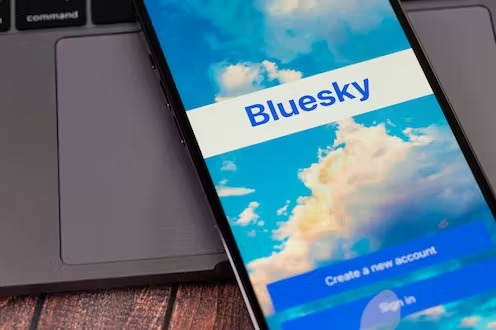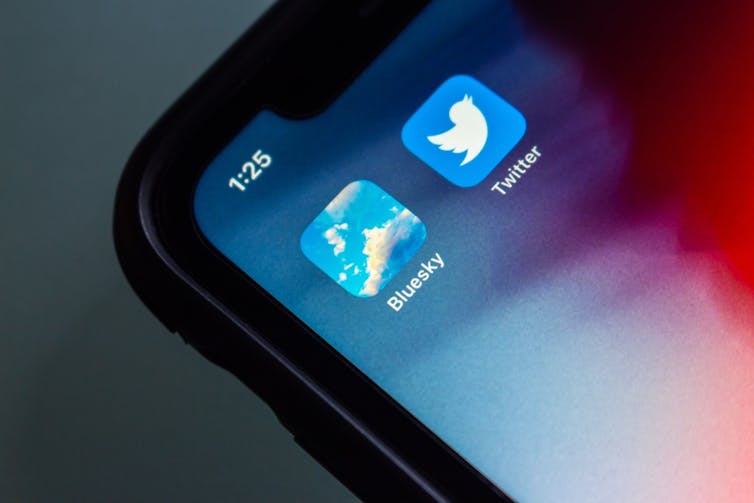Amid management changes at Twitter, discontented users are exploring an alternative social media platform called Bluesky. According to media reports, downloads of the Bluesky app surged more than 600% in April.
Initially conceived by Twitter co-founder Jack Dorsey in 2019 as a complementary project aimed to improve Twitter user experience, Bluesky transitioned into a standalone project in early 2022, and its iOS app was released in February this year followed by an Android version in April.
Visually, Bluesky looks similar to Twitter. The timeline is called the “skyline” and tweets are “skeets”. It has two main differences that drive its popularity – decentralisation and invite-only access.
Decentralisation was a driving force behind Dorsey’s creation of Bluesky. So what does that mean and how’s this app different to Twitter?
‘Decentralised’ social media
Dorsey is a big proponent of decentralised control and cryptocurrency. He believes centralised platforms like Twitter cannot address issues such as enforcement of policies to address abuse and misinformation, and the proprietary algorithms are not meeting user needs.
Twitter uses an AI-powered, centrally managed algorithm to moderate what content the user is exposed to.
On Bluesky, however, users have control over the algorithm that selects what they are exposed to. As Wired magazine explained:
Crucially, users and servers will be able to label posts or specific users - e.g., with a tag like “racist” — and anyone can subscribe to that list of labels, blocking posts on that basis.
Bluesky calls this concept a “composable, customizable marketplace of algorithms that lets you take control of how you spend your attention.”
In addition to giving users more control over what kind of content they see, Bluesky has plans to “decentralise” control of social media even further. If all goes well, Bluesky itself will just be the first of many interconnected social networks running on the same basic principles.
Bluesky is based on what it calls the AT protocol, a network that allows servers to communicate with each other. This means that, hypothetically, you could move your account between different social networks that also use the AT protocol without losing your content and followers.
It’s worth noting this is all a bit theoretical for now; this functionality can’t be used yet.
But it is designed to eventually address the concerns of social media influencers who fear losing their audience due to platform rule changes or when choosing to move to a different platform.
Invite-only
Another distinguishing factor of Bluesky is that, for now anyway, it is invitation-only.
Most social media platforms, including Twitter, allow users to register freely. Bluesky, however, requires an invitation code. Existing users receive invitation codes fortnightly.
Despite at least 360,000 Bluesky app downloads, it’s been reported there are only 70,000 users. Media reported earlier this month there were a staggering 1.9 million people on the waitlist.
With so many people curious to get in, the Bluesky invites became a hot commodity. You can find them on eBay between A$50 and $200; some listings were asking much more.
The invitation-only design ensures steady user growth, avoiding a rapid influx of users followed by a sudden loss of interest.
And potential new users who patiently wait for an invitation are already familiar with Bluesky. Flooding other social media platforms with requests for invitation codes creates extra interest, too.
Every new Bluesky user knows at least one existing user. It ensures users have something in common to post about.
It would seem Bluesky’s creators aimed to selectively bring in like-minded individuals from the start, rather than attempting to retrospectively eliminate problematic users.
Thanks to a great deal of user control over the content they see, and a small and selective user base so far, many report they’ve found a friendly atmosphere and good vibes on Bluesky.
Others say it feels almost like a group chat. Bluesky has particularly resonated with marginalised communities, especially transgender people, who may feel safer there expressing themselves than on other social media sites.
Many Twitter users have flocked to Bluesky. Shutterstock
But will any of this last?
As we’ve all seen, social media sites come and go.
Social media site Mastodon experienced explosive user growth in November last year, reaching 2.6 million users within weeks, only to decline to 1.2 million within a couple of months.
Decentralised moderation challenges on Mastodon have resulted in what some users have described as a “stuffy” culture. This, coupled with the complicated interface and the hard to grasp concept of “belonging” to a server, may have affected its chance of lasting success.
Unlike Mastodon, Bluesky has a simple and straightforward interface. To remain relevant in the long term, Bluesky must strike a delicate balance between curbing hate speech and trolls while maintaining engaging content and discussions. All while being more captivating than your inner-circle group chats.



 OpenAI CEO Sam Altman's Worldcoin Unveils Human-Centric Blockchain, World Chain
OpenAI CEO Sam Altman's Worldcoin Unveils Human-Centric Blockchain, World Chain  Shiba Inu Team Member Sounds Alarm, Calls for Immediate Action Against Scams
Shiba Inu Team Member Sounds Alarm, Calls for Immediate Action Against Scams  Samsung Implements Emergency 6-Day Work Week to Combat Slowing Growth
Samsung Implements Emergency 6-Day Work Week to Combat Slowing Growth  BMW Offers Up to $13,000 Off 2024 EV Models; Kia's Affordable Electric Cars Set to Compete
BMW Offers Up to $13,000 Off 2024 EV Models; Kia's Affordable Electric Cars Set to Compete  Microsoft Exposes Early Russian Influence Efforts Ahead of US Elections
Microsoft Exposes Early Russian Influence Efforts Ahead of US Elections  Shibarium Soars 160% as Key Metric Rebounds, Signaling Recovery
Shibarium Soars 160% as Key Metric Rebounds, Signaling Recovery  Railgun Denies North Korean Use, Approaches $1B Volume Amid Vitalik Buterin's Praise
Railgun Denies North Korean Use, Approaches $1B Volume Amid Vitalik Buterin's Praise  Amazon Ditches Its ‘Just Walk Out’ Cashierless Shopping Tech, Decides to Offer the System to Other Stores
Amazon Ditches Its ‘Just Walk Out’ Cashierless Shopping Tech, Decides to Offer the System to Other Stores  Tesla's Flood Resilience Tested by Dubai's Historic Rainfall
Tesla's Flood Resilience Tested by Dubai's Historic Rainfall  Tesla Cybertruck Gets Major Upgrades in Exciting Spring Update
Tesla Cybertruck Gets Major Upgrades in Exciting Spring Update  Samsung's Exynos 2500 Rumored to Eclipse Snapdragon 8 Gen 4 in Power Efficiency With 3nm SoC
Samsung's Exynos 2500 Rumored to Eclipse Snapdragon 8 Gen 4 in Power Efficiency With 3nm SoC  AMD Targets Nvidia, Intel with New AI Chips for Gaming and Business PCs
AMD Targets Nvidia, Intel with New AI Chips for Gaming and Business PCs  MEW Coin Eyes Recovery with New Bybit Listing, Sparks Investor Interest
MEW Coin Eyes Recovery with New Bybit Listing, Sparks Investor Interest  Tesla Enhances Sentry Mode with Remote Viewing, Promises Spring Software Boost
Tesla Enhances Sentry Mode with Remote Viewing, Promises Spring Software Boost  Senators Push for Stablecoin Regulation to Protect US Dollar Dominance
Senators Push for Stablecoin Regulation to Protect US Dollar Dominance  Bitwise: Market Underestimates Long-Term Impact of Upcoming Bitcoin Halving
Bitwise: Market Underestimates Long-Term Impact of Upcoming Bitcoin Halving  Animoca Founder Predicts Bitcoin to Reach $1M, Not Just as Store Value, at Rio Summit
Animoca Founder Predicts Bitcoin to Reach $1M, Not Just as Store Value, at Rio Summit 
































